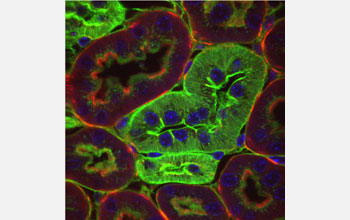Multimedia Gallery
Improved Biomedical Imaging (Image 1)
This image showing the cells inside a mouse kidney was obtained using 15 femtosecond laser pulses.
The development of improved biomedical imaging methods depends on the ability of microscopes to detect a signal only from a focal spot. In the case of this image, without pulse compression the signal would be a factor 45 times weaker. Improving these nonlinear, optical imaging modalities requires the delivery of ultrashort pulses at the focal plane, a task that is complicated by the significant dispersion introduced by the microscope objective lens.
Marcos Dantus in the chemistry department at Michigan State University and colleagues developed rapid, ultrashort pulse lasers and the technology to measure and correct the dispersion in an optical path. Their research is yielding increased signal and reduced, laser-induced damage in biomedical imaging. This work is part of a multidisciplinary Major Research Instrumentation grant from the National Science Foundation (grants CHE 04-21047 and CHE 05-00661). (Date of Image: 2007) [Image 1 of 2 related images. See Image 2.]
Credit: Marcos Dantus, Department of Chemistry, Michigan State University; Photo by Kurt Stepnitz, Michigan State University
Images and other media in the National Science Foundation Multimedia Gallery are available for use in print and electronic material by NSF employees, members of the media, university staff, teachers and the general public. All media in the gallery are intended for personal, educational and nonprofit/non-commercial use only.
Images credited to the National Science Foundation, a federal agency, are in the public domain. The images were created by employees of the United States Government as part of their official duties or prepared by contractors as "works for hire" for NSF. You may freely use NSF-credited images and, at your discretion, credit NSF with a "Courtesy: National Science Foundation" notation.
Additional information about general usage can be found in Conditions.
Also Available:
Download the high-resolution JPG version of the image. (1.5 MB)
Use your mouse to right-click (Mac users may need to Ctrl-click) the link above and choose the option that will save the file or target to your computer.

